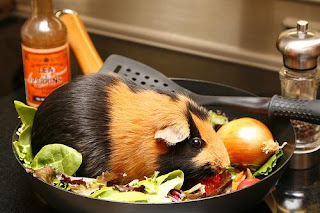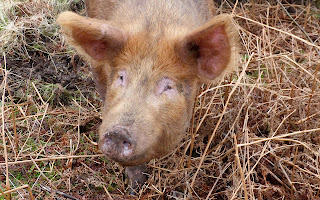Part of the plan for going to Bulgaria has always involved attempting to be as self sufficient as possible.
I want this to encompass growing crops, producing power and also keeping animals.
I will cover the other two specifics in another post but this one is focusing on the thoughts I have right now regarding livestock and animals. I think I will find this very interesting to look back on in a few years when everything is different and all my thoughts and plans are proved to be completely misguided and without logic or a chance of succeeding :) but such is life.
 |
| A chick in an egg |
First of all, and most obviously, I hope to keep chickens. They are relatively easy to care for and I am planning on two herds (is that the right word?) one for eggs and one for meat. Chickens have the additional benefit of providing some good shit for compost and also they eat insects which attack your crops.
Of the other livestock I am thinking of getting early on I have picked two rather unusual animals.
 |
| A drawing of a hare |
I really like eating rabbit and, as rabbits are small and hares are bigger, I am going to attempt to breed hares for meat. I have no idea how this will turn out or even how to start; where do you get breeding pairs for hares from in Bulgaria? That's probably the first question to have answered and probably the first of many. Hares do run wild in Bulgaria (I have had to avoid them on the road more than once and E is on a mission to get a clear photograph of one which is regular in her garden) so I know they will survive the climate.
 |
| Mmmmm tasty |
Finally for the set of animals for this first round is the most unusual of the three. This decision was prompted by an article on the
BBC *spits* about how they are eaten very commonly in South America and are very good BBQed. I aim to have a brick built BBQ done in the first few weeks of arriving so BBQ food is a good thing. Guinea Pigs are easy to keep, breed fast and can be kept inside so will be easy to look after when the temperature drops.
Longer term I have plans for keeping other animals.
 |
| A nanny goat |
I would love to keep a couple of goats. They can provide you with milk and, by extension, cheese and also are good companion creatures for other animals.
 |
| Oink! |
I am also considering a breeding pair of pigs; the parents will be excellent for turning waste into manure and they are also natures very best rotavators for digging up tough land and I have a fair amount of that I will eventually be looking to put into production.
Other people have mentioned maybe keeping a couple of turkeys for the eggs and freezer, and there is a chance that I could have some sheep running with a local herd where I will get the meat at slaughter time.
As I said at the beginning of this post this is all very early thoughts and I am certain that many parts, if not all of it, will change as thoughts turn to reality. If you have any observations or relevant knowledge please do add them as comments below; I am aware just how much I need to learn here.
Edit - this is a really useful link which I just came across researching Guinea Pigs - it covers all these animals as livestock :: http://www.fao.org/docrep/004/y0500e/y0500e05.htm





'Stampede'. It's a stampede of chickesn. *nods sagely* Yes, indeedy... :o)
ReplyDeleteHaha it is when you're about to feed them at least :)
DeleteIt's a flock of chicken AFAIK, although if they're laying eggs they should be called hens and if raised for meat - broilers.
ReplyDeleteWe raise some (30-ish) hens and some (20-ish) rabbits: they are a great source of manure among other things. But you have to be OK with shoveling shit around...
Loving the count down clock :)
ReplyDeleteunlike rabbits, hares are solitary creatures and would not thrive. Guinea pigs were introduced to the uk as a meat source but were just too damned cute! Can I suggest you get yourself John Seymours book on Self-suffiency. He and his wife were the inspiration behind the Good Life series on TV. One of his books describes in detail how to farm 5 acres of land to provide enough food for a family. Great stuff.
ReplyDelete